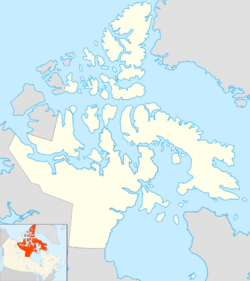Bruce Island (Nunavut) facts for kids
| Geography | |
|---|---|
| Location | Frobisher Bay |
| Coordinates | 63°19′N 67°27′W / 63.317°N 67.450°W |
| Archipelago | Canadian Arctic Archipelago |
| Area | 11 km2 (4.2 sq mi) |
| Coastline | 23 km (14.3 mi) |
| Administration | |
|
Canada
|
|
| Territory | Nunavut |
| Region | Qikiqtaaluk |
| Demographics | |
| Population | Uninhabited |
| Source: Bruce Island at the Atlas of Canada | |
Bruce Island is a small, uninhabited island located in the far north of Canada. It's part of Nunavut, Canada's largest and newest territory. This island sits in a large body of water called Frobisher Bay, which is part of the Canadian Arctic Archipelago.
Contents
Discovering Bruce Island
Bruce Island is a fascinating piece of land in the Arctic. It's an offshore island of Baffin Island, one of the biggest islands in the world. Being "offshore" means it's near the coast but not directly connected to the mainland.
Where is Bruce Island Located?
Bruce Island is found within Frobisher Bay. This bay is a large inlet of the Atlantic Ocean in the Qikiqtaaluk Region of Nunavut. The island is located south of an area called Ward Inlet.
- To the northwest of Bruce Island, you'll find the Becher Peninsula.
- To the east, there's the Hall Peninsula.
- Other islands nearby include Field Island and Chase Island to the southeast.
- To the west, you can see Fletcher Island, Pike Island, and Pugh Island.
What is the Canadian Arctic Archipelago?
The Canadian Arctic Archipelago is a huge group of islands in northern Canada. It includes thousands of islands, big and small, that stretch across the Arctic Ocean. Bruce Island is one of these many islands. This area is known for its cold climate, ice, and unique wildlife.
Life on Bruce Island
Bruce Island is currently uninhabited, meaning no people live there permanently. Its remote location and harsh Arctic climate make it a challenging place for human settlement.
Size and Features
Bruce Island covers an area of about 11 square kilometers (about 4.2 square miles). Its coastline stretches for 23 kilometers (about 14 miles). While it's not a huge island, it's big enough to be a home for various Arctic plants and animals.
Wildlife and Environment
Even though people don't live on Bruce Island, it's part of a vibrant Arctic ecosystem. The Canadian Arctic is home to many animals adapted to the cold, such as polar bears, seals, and various types of birds. The waters around the island are also important for marine life. The environment here is very sensitive, and changes in climate can have a big impact on the plants and animals that call this region home.



